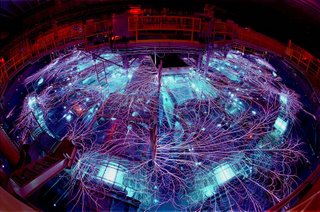I remember reading about it.
The hottest temperature ever created by mankind on this planet. At that time, I didn't think much of it except for a cursory interest.
Hottest temperature. HHhhmmmmm. It was a cool concept, but in a distant manner that showed how far it was from a common, everyday (and most importantly) practical application. I didn't think much about it and the curiousity faded quickly.
And then I surfed by APOD and found this picture.
How bloody cool is that picture?
If you don't have time for the explanation or to read the article, allow me to present a snippet.
Sandia’s Z machine normally works like this: 20 million amps of electricity pass through a small core of vertical tungsten wires finer than human hairs. The core is about the size of a spool of thread. The wires dissolve instantly into a cloud of charged particles called a plasma.
The plasma, caught in the grip of the very strong magnetic field accompanying the electrical current, is compressed to the thickness of a pencil lead. This happens very rapidly, at a velocity that would fly a plane from New York to San Francisco in several seconds.
At that point, the ions and electrons have nowhere further to go. Like a speeding car hitting a brick wall, they stop suddenly, releasing energy in the form of X-rays that reach temperatures of several million degrees — the temperature of solar flares.
Holy shit. Solar flares. I'm amazed. When it's explained in simple laymen terms, it all suddenly becomes that much more cool.
Go science!!



2 comments:
First off cool picture.Second that was informative and cool. Now all they gotta do is figure out how to make it economical and safe to use as a energy source.
Peace
Hi Greg,
VERY glad to see you back online!
Yes, I thought that picture was absolutely amazing. Cutting edge of sciene, indeed!
Post a Comment